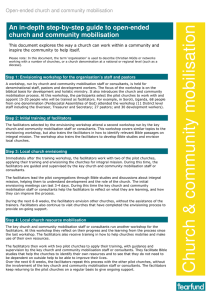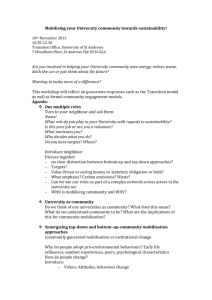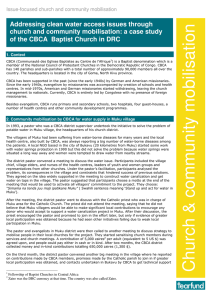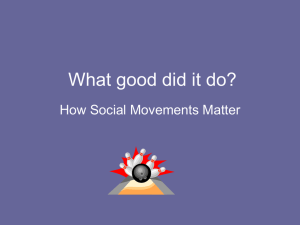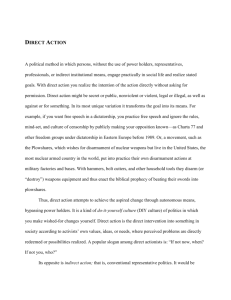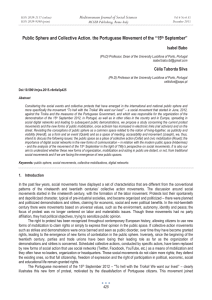mehreen post class Political opportunity structures
advertisement
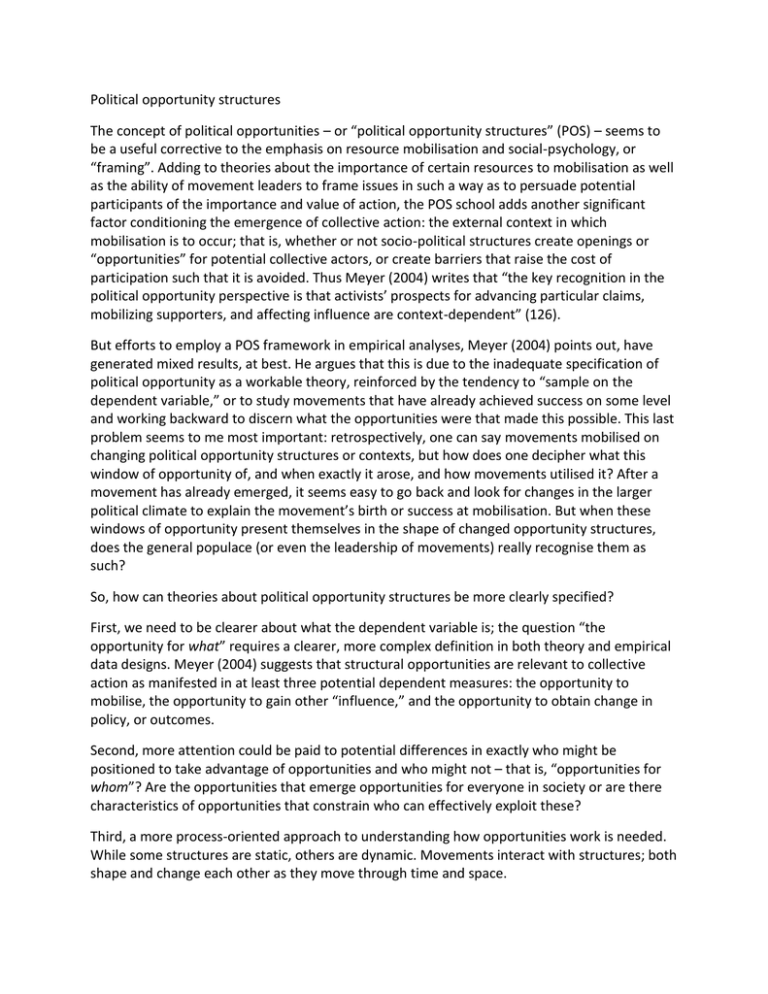
Political opportunity structures The concept of political opportunities – or “political opportunity structures” (POS) – seems to be a useful corrective to the emphasis on resource mobilisation and social-psychology, or “framing”. Adding to theories about the importance of certain resources to mobilisation as well as the ability of movement leaders to frame issues in such a way as to persuade potential participants of the importance and value of action, the POS school adds another significant factor conditioning the emergence of collective action: the external context in which mobilisation is to occur; that is, whether or not socio-political structures create openings or “opportunities” for potential collective actors, or create barriers that raise the cost of participation such that it is avoided. Thus Meyer (2004) writes that “the key recognition in the political opportunity perspective is that activists’ prospects for advancing particular claims, mobilizing supporters, and affecting influence are context-dependent” (126). But efforts to employ a POS framework in empirical analyses, Meyer (2004) points out, have generated mixed results, at best. He argues that this is due to the inadequate specification of political opportunity as a workable theory, reinforced by the tendency to “sample on the dependent variable,” or to study movements that have already achieved success on some level and working backward to discern what the opportunities were that made this possible. This last problem seems to me most important: retrospectively, one can say movements mobilised on changing political opportunity structures or contexts, but how does one decipher what this window of opportunity of, and when exactly it arose, and how movements utilised it? After a movement has already emerged, it seems easy to go back and look for changes in the larger political climate to explain the movement’s birth or success at mobilisation. But when these windows of opportunity present themselves in the shape of changed opportunity structures, does the general populace (or even the leadership of movements) really recognise them as such? So, how can theories about political opportunity structures be more clearly specified? First, we need to be clearer about what the dependent variable is; the question “the opportunity for what” requires a clearer, more complex definition in both theory and empirical data designs. Meyer (2004) suggests that structural opportunities are relevant to collective action as manifested in at least three potential dependent measures: the opportunity to mobilise, the opportunity to gain other “influence,” and the opportunity to obtain change in policy, or outcomes. Second, more attention could be paid to potential differences in exactly who might be positioned to take advantage of opportunities and who might not – that is, “opportunities for whom”? Are the opportunities that emerge opportunities for everyone in society or are there characteristics of opportunities that constrain who can effectively exploit these? Third, a more process-oriented approach to understanding how opportunities work is needed. While some structures are static, others are dynamic. Movements interact with structures; both shape and change each other as they move through time and space. Also, there is need differentiate real changes in structural realities that make action easier to undertake from cues that are likely to be interpreted as opportunities primarily by attentive collective action leaders but not by the general populace. Indeed, certain factors that might appear to be opportunities might actually be, or might become over time, factors that produce reductions in mobilisation, group formation, or other dependent outcomes (when does this happen?). Questions/comments: 1. What is the differences between resources and opportunities? Is POS theory simply a variation of the resource mobilisation perspective? 2. When is the POS proposition falsified? Also, when do increasing opportunity structures provide a disincentive to political action and reduce protest? (Assume that opportunities increase in a society and that the citizens regard joint action as successful. The expected success of joint action does not mean that the individual incentives to participate will be high. In this situation, the free rider problem becomes particularly salient; the individual actor will believe that many others will participate, that their participation will provide the public good, and that one’s own participation is therefore not necessary. Thus, increasing opportunities are only effective if there is an increase of perceived personal influence or other incentives to protest. In other words, increasing opportunity structures need not provide the incentives to overcome the free rider problem. Fields Raka Ray extends Bourdieu’s idea of a field to define a political field as “a structured, unequal, and socially constructed environment within which organizations are embedded and to which organizations and activists constantly respond” (Ray 22). It includes the state, political parties, and social movement organisations, often with varying levels of power but all tied together by a particular political culture or legitimate ways of doing politics (Ray 22-23). Similar to other perspectives that stress external conditions rather than internal social movement dynamics, the concept of political field takes account of how external cultural and ideological circumstances, as well as resource and institutional factors, shape social movement outcomes. Within a given political field lies a “protest field” that includes “groups and networks that oppose those who have the power in the formal political arena” and may or may not share the logic of politics in the larger political field, although they are constrained by it (Ray 22). Ray assumes the existence of recursive connections between a political field and the oppositional social movements existing within it, although she assigns predominant causal weight to field conditions in producing movement outcomes. While the concept of field is a useful heuristic for exploring social movement differences, it is complicated by the fact that localised fields or sites are frequently impacted by developments in regional and international political fields. Such developments may be harder to chart and study than changes in local sites. Fields exist at different scales at any given historical moment and “external” fields often become more or less relevant to the dynamics within a political-socialgeographic field and can shift the scale and focus of movement strategies and demands, as well as the responses of state and other actors. Moreover, developments in local protest fields can themselves quickly produce regional and international responses whose impact demonstrates the importance of scale and the ways in which protest movements and state and parastatal responses to them can quickly change the dynamics in political fields at various scales. Excessive stress on political field may underestimate the ways in which the political boundaries of states do not fully encase the political and other possibilities within geographic/land boundaries since there are always less geographically bordered political, ideological, and cultural processes to contend with.
